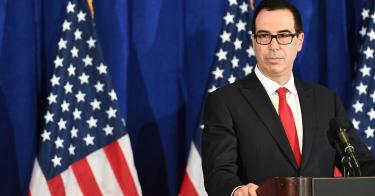The debt ceiling is knocking on the administration’s door. As U.S. Treasury secretary, Steven Mnuchin will be in charge of determining how to deal with this unwelcome visitor.
Mnuchin’s predecessor, Jack Lew, greeted the ceiling’s approach with loud, doom-and-gloom warnings of impending U.S. default. It rattled markets needlessly. Mnuchin can better serve the country by staying the current course and reassuring U.S. investors at home and abroad that the federal government is good for its debts.
The debt ceiling is always a tricky issue, both politically and technically. Unlike an expenditure limit that stops spending in its tracks, the debt ceiling puts a stopper on the flow of federal funds after they have already been obligated.
This puts Congress and the administration in a tough spot. Absent new and novel sources of revenues — such as asset sales, for example — the two branches of government rely ultimately on reaching an agreement to raise the debt ceiling, allowing Washington to borrow the funds needed to pay its obligated balances.
This does not mean that Congress and the administration have no options but to simply raise the debt ceiling. A more responsible path forward would pair any increase in the debt limit with long overdue spending reforms to put controls on debt growth.
Congress and the administration must not just seek a higher credit limit. It would only encourage further fiscal profligacy. Instead, the approaching debt ceiling ought to trigger vigorous debate on which nonessential items will be cut out of the budget and how projected spending growth will be contained.
The American people understand this. In poll after poll, they have strongly supported tying spending cuts to any increase in the debt limit. Advocates of a so-called “clean” debt ceiling increase claim that adding in spending restraints would be irresponsible. But not putting brakes on our growing debt is the truly reckless choice. “Clean” means staying on the current spending course, which is a fiscal death spiral.
The Congressional Budget Office’s latest projections in June show interest on the debt skyrocketing to more than $800 billion annually by 2027. At that point, interest payments would exceed spending for national defense. Spending on interest and entitlement program are already effectively crowding out investment in other national priorities. Left as is, the squeeze will be intolerable within a decade.
Attaching requirements for sensible and necessary spending cuts to any increase in the debt ceiling in no way puts the full faith and credit of the United States at risk. If lawmakers succeed at implementing long overdue reforms, they will have accomplished just the opposite.
Budget reforms are crucial to correcting the nation’s unsustainable fiscal course. Once implemented, they will create greater certainty for U.S. consumers, businesses and investors that a prosperous future lies ahead. This will unleash investment and economic growth that is currently stuck on the sidelines.
Tax reform is a critical component. Congress must adjust both sides of the fiscal ledger, providing tax relief and a tax code more conducive to production and employment in America. At the same time, lawmakers must reduce the burden of spending that increases pressure for higher future taxes.
The congressional budget resolution recently introduced in the House represents a small step in the right direction. It pairs tax reform instructions with $200 billion in mandatory spending cuts. Cutting spending and taxes is the winning approach. Congress should embrace it — and go bigger!
Should such debate lead to a temporary debt limit impasse, the Treasury has broad discretion to ensure continued servicing of principal and interest on the national debt. Secretary Mnuchin and his department have tools at their disposal to prioritize spending at the debt ceiling.
Unlike the Obama administration, which demonstrably lied to Congress about the mechanisms in place to ensure the U.S. can keep paying for the debt, Mnuchin should reassure the world that he will do everything in his power to avoid a U.S. default.
With default off the table and an honest Treasury that does not sow lies and sound alarms for political leverage, Congress and the administration can finally focus on the real fiscal crisis: how to stop debt from growing further out of control.
This piece originally appeared in The Hill on 7/24/17



